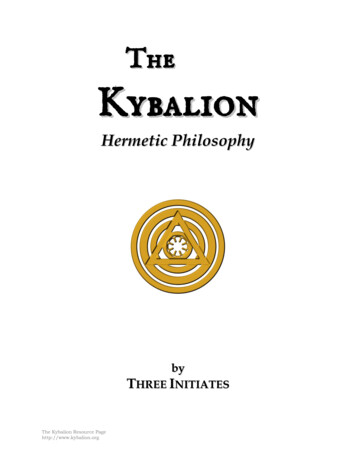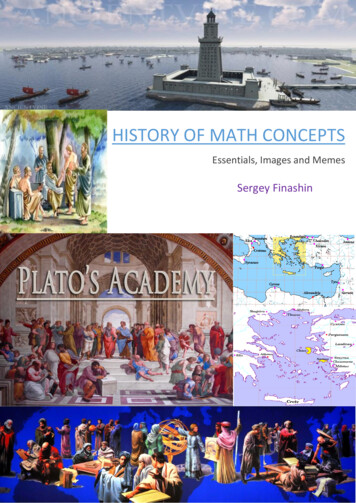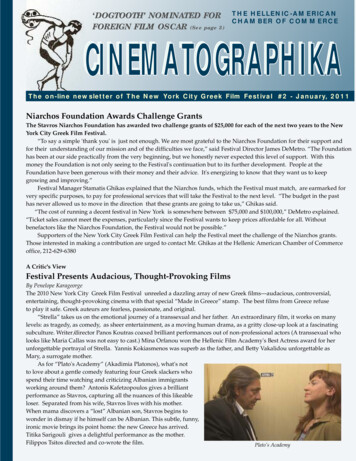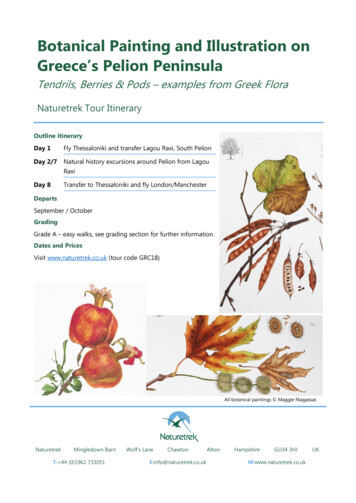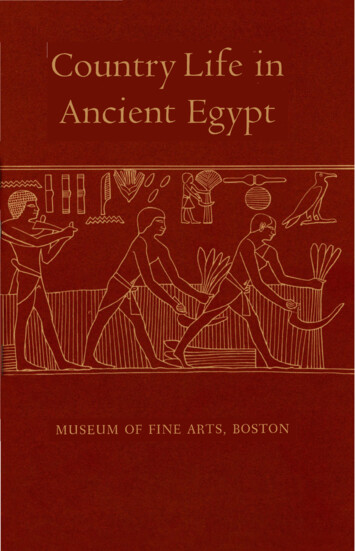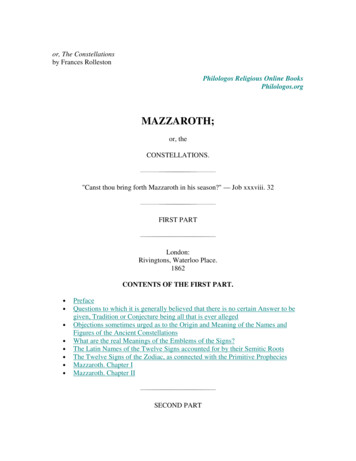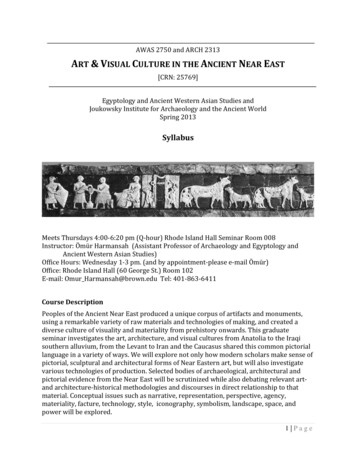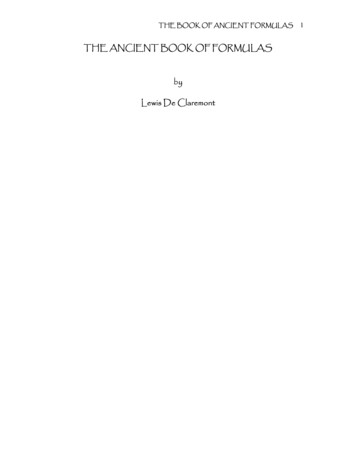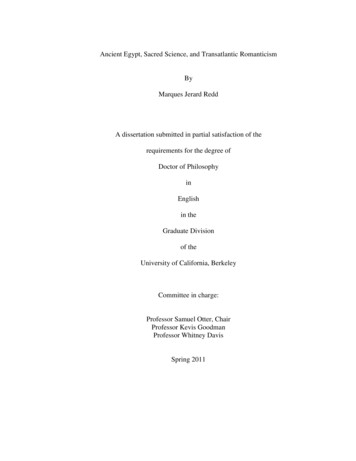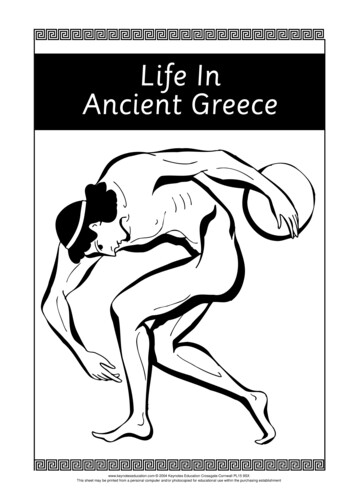
Transcription
Life InAncient Greecewww.keynoteseducation.com 2004 Keynotes Education Crossgate Cornwall PL15 9SXThis sheet may be printed from a personal computer and/or photocopied for educational use within the purchasing establishment
Name:Life in Ancient Greece1ANCIENT GREECE - AN INTRODUCTIONGreece is a country located in southernEurope between Albania and Turkey. Itborders the Aegean Sea, Ionian Sea and theMediterranean Sea. Greece not only has itsmainland but over 2,000 small islandsdotted around its coasts.Thousands of years ago ancient Greece wasa great civilisation that existed Before Christ(B.C.). It was much larger than the mainlandand islands of today as it spread west acrosswhat is now Italy and south as far as Egypt.The weather in ancient Greece was mild,wet winters and hot, dry summers.Ancient Greek people all shared the samelanguage and religion but the did not livein a united country like today. Each flatarea was made up of an independentcity-state or polis which had its own lawsand customs. It was the mountains aroundeach city-state that provided a naturalborder and defences against theneighbours! Strong city-states becamemore powerful by conquest rather than bykind agreement and the two most largestcity-states were Athens and Sparta.Using travel brochures collected froma local travel agent find pictures thattell us something about the Greekclimate.Make a weather collage for Greeceusing the pictures you find and yourown drawings.Ancient Greek towns had high wallssurrounding them with a temple called anacropolis built high up inside the walls.There was an open-air theatre called anamphitheatre and an agora in each town.The agora was a large square surroundedby the public buildings, law courts and shopsand was used for markets, business, meetingfriends and having a good gossip!The word ancient means very old. Somebuildings around you may have been built200 or more years ago, but ancient Greekbuildings are now over 2,400 years old. Nowonder they are in ruins! The civilisationof ancient Greece lasted from about 2,000B.C. to 200 B.C. with its most importantperiod being from 500 B.C. to 300 B.C. Duringthis time they produced many importantideas about art, architecture, medicine,sport, science and mathematics.www.keynoteseducation.com 2004 Keynotes Education Crossgate Cornwall PL15 9SXThis sheet may be printed from a personal computer and/or photocopied for educational use within the purchasing establishment
Name:Life in Ancient Greece2A N C I E N T G R E E C E - ATHENSAthens was the intellectual city-state ofancient Greece. Education and the artswere very important to the people ofAthens. Excellence was their goal ineverything they did. It is because they triedso hard in everything they did that theyaccomplished so much and proved to be asociety way ahead of their time!The people of Athens believed thatindividuals should be free as long as theyfollowed the law. This allowed them tostudy or develop themselves in any waythat they wished and led to a wealth ofgreat Greek thinkers and philosophers.Athens was named after Athena, the Greekgoddess of wisdom. In 508 B.C. it became oneof the first societies in ancient times toestablish democracy. The word democracycame from the Greek words, demos, meaningpeople, and kratein, meaning to rule.Look up the word democracy in a dictionaryand write down the meaning below.This democratic form of government wascarried out at a meeting place which theGreeks called the Assembly. The people ofLook up the word philosophy in a dictionary Athens met there every month and discussedand write down the meaning below.issues. After these meetings the governmentofficials could make decisions and laws.The Acropolis was the religious centre andfortress for the Athenian people. Its wallsNow write down the meaning of philosopher. were built overlooking the city and insidethe walls the people of Athens built templesand buildings. The Parthenon is the mostfamous building in the Acropolis today.The people of ancient Athens were masterbuilders, architects and great lovers of art.Their talents in the arts can be seen throughmany different items which have survivedfor thousands of years. These include itemssuch as vases, sculptures and jewellery.The ParthenonAthenian men were required to serve twoyears in the military, one in the garrison andone in a border fort.www.keynoteseducation.com 2004 Keynotes Education Crossgate Cornwall PL15 9SXThis sheet may be printed from a personal computer and/or photocopied for educational use within the purchasing establishment
Name:Life in Ancient Greece3A N C I E N T G R E E C E - SPARTAIt is hard to say anything nice at all aboutthe Spartans! Historians have said thatthey were a brutal lot who were lackingin culture and kindness! All this asideSparta was the greatest military power ofancient Greece with its own laws, moneyand kings.Life in Sparta was very much harder thanlife in the cultural city-state of Athens.The people of Sparta were led by its kingand had to follow very strict military-likerules. Athens was the bitter enemy andrival of Sparta and the two statesrepresented opposite concepts of ancientGreek living. Despite their hardships theSpartans believed they lived in the best ofall Greek states and were very proud of it.Many of their Greek neighbours agreedwith them; or were they too frightenedto disagree? The rivalry between Spartaand Athens finally led to a disastrous warfor Athens.Spartans were so devoted to their militarylives they had to rely on a huge populationof agricultural slaves called helots tofarm and provide food for them in thesurrounding farm land. Of course this landwas owned by Spartans and not the slaves!The life of the helots was a miserable one.Farm labour was long and hard and theybarely had anything to eat for themselves.Imagine the uproar if this happened today.When children were born the statedecided if the child was strong enough tobe a future soldier and if they weren’tthey were left in the hills to die from cold.At the age of seven every boy was sentto military and athletic school. Theseschools taught toughness, discipline andsurvival skills. At twenty, after thirteenyears of training, the boy became a soldierwhere he worked until he died or reachedthe age of sixty.GreeceAthensOlympiaSpartaSparta did not produce any art or philosophy,or leave us any written work, but its peoplewere admired for being brave and strong.TIMELINEOn the timeline below colour in the period of ANCIENT GREECE.3000 BC2000 BC1000 BC1 AD1000 ADwww.keynoteseducation.com 2004 Keynotes Education Crossgate Cornwall PL15 9SXThis sheet may be printed from a personal computer and/or photocopied for educational use within the purchasing establishment2005 ADToday!
Name:Life in Ancient Greece4COMPARING ATHENS AND SPARTAIn the table below are statements about life in ancient Greece.Answer yes or no for each statement in relation to Athens and Sparta.Statement1.AthensIn this city-state the people liked art.2. The people here were known as great fighters.3. The people here were great thinkers and writers.4. These people had slaves called helots to farm for them.5. Boys were sent to military school for 13 years.6. These men served in the army for many years.7. These men served in the army for two years.8. Individuals were free to do what they wanted.9. These people lived in a democracy.10. These people had strict rules they had to follow.11. These people were master builders and architects.12. These people believed in a good all-round education.13. These people had excellence as their goal.14. This state was named after the Greek goddess of wisdom.15. These people were brutal and rough.www.keynoteseducation.com 2004 Keynotes Education Crossgate Cornwall PL15 9SXThis sheet may be printed from a personal computer and/or photocopied for educational use within the purchasing establishmentSparta
Name:Life in Ancient Greece5WARFARE IN ANCIENT GREECEThe ancient Greeks had different kinds ofarmies throughout their history and theearly armies were disorganised and badlyplanned. Later, a better kind of armydeveloped where weaponry, tactics andfighting formations were improved. Thesenew armies had javelin throwers, men onhorseback and foot soldiers called hoplites.Most of the time the armies were fightingtheir neighbouring city-state’sarmy but they did have to fightpeople from other lands too.There were only three times when differentGreek city-states fought as a united armyto defeat a larger power. This happenedduring the Persian Wars of 490 B.C. and 333B.C. and again in 331 B.C. under the leadershipof Alexander the Great.The hoplite was a heavily armed soldier.His two weapons were a double-bladedsword and an eight foot pike for thrusting.He carried a round shield and wore abreastplate of metal and leather, a helmetand metal shin protectors called greaves.These men were much faster and strongerthan those before them.When in battle soldiers stood shoulder toshoulder in long lines about eight rows ofmen deep. The men in the front line heldtheir shield strapped to their left arm andtheir sword in their right hand. Thisprotected the man on their left while theythemselves were being protected by theman on their right. Slowly the strongerarmy moved forward together whilefighting and defeating their opponent.Colour in the pictureof the hoplites. Whatcolours do you thinktheir weapons, armourand robes wereconsidering what theywere made from?Try to be as realisticas possible.www.keynoteseducation.com 2004 Keynotes Education Crossgate Cornwall PL15 9SXThis sheet may be printed from a personal computer and/or photocopied for educational use within the purchasing establishment
Name:Life in Ancient Greece6THE HOPLITES - SOLDIERSColour in and label the armour andclothes on this picture of a hoplite?Early ancient Greek soldiers had to provide theirown equipment including their weapons. Thepoorer you were the worse weapons you had whichmeant you were destined to be a foot soldier.As time went by the lower and middle classesbegan to get richer so soldiers could afford betterarmour and weapons. By 500 B.C. the soldiers wereheavily armed and called hoplites.There were no strict uniforms as such but as yearswent by different city-states adopted differentitems which made them identifiable. The Spartanhoplites wore scarlet red and the hoplites fromAthens had a large letter A on their shields.A hoplite from Sparta had to serve in the armyuntil he was sixty but in Athens hoplites servedfor only two years. After the two years were upthe men were put on a reserve list and onlycalled up if there was a war.Imagine you were a hoplite in this picture.Write a short story on your day in battle.www.keynoteseducation.com 2004 Keynotes Education Crossgate Cornwall PL15 9SXThis sheet may be printed from a personal computer and/or photocopied for educational use within the purchasing establishment
Name:Life in Ancient Greece7THE ANCIENT GREEK NAVYThe ancient Greek navy was one of themost powerful fleets of the time. The navalboats were called triremes and would havebeen no match for today's naval fleetalthough at the time they were the bestthat naval technology had to offer.The trireme was built for speed and mobilityand had one or two sails with a carved bow.They were 120 feet long and were poweredby 170 rowers arranged in 3 rows. Theywere very low to the water and verynarrow. The bottom row of rowers werejust 45 cm above the water! Not great onthe open ocean! Rough seas would soonsink a low trireme but they were great forshort battles close to shore.The crew of a trireme usually consisted of203 men. A modern destroyer might havebetween 300 and 500 men. Most of thecrew were one of the 170 rowers and theywere also the soldiers. Besides the 170rowers a trireme's crew was made up of 14spearmen, 4 archers and 25 officers.The captain of a trireme was usually apolitical man who knew nothing aboutwarfare so the command of the ship usuallyfell to the kybernetes, or helmsmen. Nextcame the proreus, the lookout, who was incharge of the foredeck. The lowest rankedofficer was the pentecontarchos who wasin charge of wages and administration.Another important man was the carpenter,who was often needed for repairs on thesewooden ships!Using the text on this page label this drawing of a trireme.www.keynoteseducation.com 2004 Keynotes Education Crossgate Cornwall PL15 9SXThis sheet may be printed from a personal computer and/or photocopied for educational use within the purchasing establishment
Name:Life in Ancient Greece8T H E B A T T L E O F M A R A T H O N - Part 1Athens was an exciting, cultural city-state but it only had a very small army. Kings fromfar away dreamed about winning over Athens and adding it to their realm.The main enemy of Athens was the far away country of Persia and in 490 B.C. Persia sentout its army to cross the Aegean Sea and capture Athens. The Persian army was 15,000men strong! This terrified the people of Athens with their small army so they askedsome other city-states for help in fighting the Persians. One small army agreed to helpthem but they really wanted the Spartans to help because they were the best fighters.Unfortunately the Spartans could not get there in time. They were in the middle of afestival of worship to Pan, one of their sacred gods, and they were not allowed to fightduring the whole month. Instead they promised to pray to Pan and ask him to help thepeople of Athens. In reply Pan said he would send a disease to afflict the Persian army!Finish this drawing of a Persian soldier.www.keynoteseducation.com 2004 Keynotes Education Crossgate Cornwall PL15 9SXThis sheet may be printed from a personal computer and/or photocopied for educational use within the purchasing establishment
Name:Life in Ancient GreeceT H E B A T T L E O F M A R A T H O N - Part 2Athens had no choice but to rally their troops and fight the Persians.They got together 10,000 men and a general called Miltiades. Miltiadesworked on a cunning war plan to confuse the Persians the nightbefore the attack. Although the Athenians were outnumberedthey fought well by confusing the Persians and breaking their ranks.The Persians began to panic and ran back to their ships in defeat. Thestate of panic they got themselves into was said to be the disease thatPan had promised to send! On the Battlefield of Marathon Athensonly lost 192 men compared to the 6,400 men lost by the Persians!One Athenian soldier called Pheidippides was a good runner and ranall the way to Athens to tell the people of the victory. The distancefrom the Battlefield of Marathon to Athens was just over 26 miles.Sadly the run was too much for him after all the fighting and whenhe reached the city steps he fell to the ground. He managed to saythe word “Nike!”, meaning victory,and then died. This run to the cityImagine you are a Persian soldier. Write downhas led to the long distance runningwhat happened to you in battle.event called the marathon.The Greeks put most of their troopson the side and fewer in the middle.They weakened the Persians from theside and then attacked from behind!www.keynoteseducation.com 2004 Keynotes Education Crossgate Cornwall PL15 9SXThis sheet may be printed from a personal computer and/or photocopied for educational use within the purchasing establishment9
Name:Life in Ancient Greece10THE ACROPOLISThe Acropolis in Athens, otherwise knownas the Sacred Rock of Athens, was and isthe most important site in the city. Duringancient Greece some of the architecturalmasterpieces of the period were built there.The term acropolis means upper city andmany of the city-states of ancient Greecewere built around an acropolis. It was theacropolis where people went for safety intimes of war. Because it was so safe mostof the sacred buildings, statues and templeswere built there. It was also seen as thereligious centre of the city-state.One of the most important buildings onthe Acropolis in Athens was the Parthenonor the Temple of Athena. It was built a longtime ago between 447 B.C. and 438 B.C. andits remains are still there today. The columnsof the Parthenon supported huge marbleslabs which contained relief pictures. Onthe eastern side of the building was a pictureof the battle between the gods and thegiants. On the west was a picture of theGreeks battling the Amazons. On the norththere was a picture of the fall of Troy andon the south was a picture of battlesbetween men and the centaurs.These can be seen at the British Museumin London today. They are now called theElgin Marbles after the man who broughtthem to England.noroseiPandSanctuaryof ZeusStatue ofAthenaTemple ofAthena NikeSanctuaryof PandionSanctuary ofArtemisnenoar thhe PTThis is a map of the Acropolis in Athens from above.Steep hills surround it.Look at photos of the ruins and write down what it looks like today and what you imagineit looked like in ancient Greece.www.keynoteseducation.com 2004 Keynotes Education Crossgate Cornwall PL15 9SXThis sheet may be printed from a personal computer and/or photocopied for educational use within the purchasing establishment
Name:Life in Ancient Greece11MOUNT OLYMPUSRead this page and complete this family tree ofthe Greek gods.HestiaHadesZeus HeraAresHephaestusAthena ApolloAthena, the goddess of wisdom.Mount Olympus is part of the tallestmountain range in Greece and isabout 50 miles southwest of the cityof Thessaloniki in northern Greece.Can you find it on a map?Mount Olympus was believed tohave been the heavenly home of theGreek gods by the ancient Greeksand it was here that Zeus had histhrone. Zeus was the big chief of allthe gods. Do you remember thatAthens was named after Athena, thegod of wisdom? Well Athena wasone of Zeus’s many children. Theancient Greeks believed that the godswould help them out in life.The other gods and goddesses thatthe ancient Greeks believed lived onMount Olympus were Hera, the wifeof Zeus; Poseidon and Hades, thebrothers of Zeus; his sisters Demeterand Hestia; and his children, Apollo,Artemis, Ares, Aphrodite, Athena,Hermes and Hephaestus.These gods and goddesses did notactually live upon Olympus, but wereancient myths and legends createdby the people. The ancient Greeksbelieved that the sacred mountainhad special powers so it seemed likethe perfect place for these gods tolive. A myth or legend is an inventedstory about an imaginary person orobject that people believein.www.keynoteseducation.com 2004 Keynotes Education Crossgate Cornwall PL15 9SXThis sheet may be printed from a personal computer and/or photocopied for educational use within the purchasing establishment
Name:Life in Ancient Greece12ANCIENT GREEK GODS - Page 1The ancient Greeks had to face many forces of nature in their lives. In the effort tounderstand these forces they invented stories to account for the things that went onin their lives. These tales, known as myths, were spread around by travellers. Theycontained the powerful gods from Mount Olympus, sea gods, woodland gods, sky gods,underwater gods, half-gods and human heroes.Suddenly, you are transported back in time and find yourself in ancient Greece! Alightning bolt strikes and you cover your eyes with your hands. When you open youreyes the room is full of strange people. gods even! But who are they? Here is a briefdescription of each to help you to get by.Match the sentences to the correct pictures of the different Greek gods.HERA is the beautiful andpowerful wife of Zeus. Sheis the goddess of marriageand birth. Her symbol is thepeacock.2ZEUS beat his father to bechief of the gods and sharedthe power with his brothers.His symbols are the eaglethunder-bolts & the oak. 1ABATHENA, favourite daughterof Zeus, is the goddess ofwisdom, war and the arts.Her symbols are the owl,spear, shield & olive tree. 3CPOSEIDON, brother ofZeus, is the god of the sea.He pounds and shakes theearth. His symbols are thehorse, bull and trident. 4Dwww.keynoteseducation.com 2004 Keynotes Education Crossgate Cornwall PL15 9SXThis sheet may be printed from a personal computer and/or photocopied for educational use within the purchasing establishment
Name:Life in Ancient GreeceANCIENT GREEK GODS - Page 2Match the sentences to the correct pictures of the different Greek gods.DEMETER, sister of Zeus,is the goddess of corn andthe harvest. Her symbolsare the sceptre, torch andcorn.6HEPHAESTUS, son ofZeus, is the god of fire andcraftsmen. He once createda beautiful woman. Hissymbol is the axe.5EARTEMIS, daughter ofZeus, is the goddess ofwildlife, archery andhunting. Her symbols arethe bow and deer.7GFAPHRODITE, daughter ofZeus, Is the goddess of loveand beauty. Her symbolsare the dove, sceptre andthe shrub called myrtle. 8HJARES, son of Zeus, Is thegod of war. He representsthe violent aspects ofhuman nature. His symbolis the spear.10APOLLO, son of Zeus, Isthe god of the sun, logicand reason. He was a finemusician. His symbols arethe bow and lyre.9Kwww.keynoteseducation.com 2004 Keynotes Education Crossgate Cornwall PL15 9SXThis sheet may be printed from a personal computer and/or photocopied for educational use within the purchasing establishment13
Name:Life in Ancient Greece14A G O D ’S T A L E - A T H E N AYour job is to illustrate this myth about Athena in the storyboard below.1. Athena was born from the 2. She sprang out fully3. Athena and her uncle,head of Zeus!grown and armed for battle. Poseidon stood on theAcropolis in Athens.4. The people of Athens5. They both wanted leader- 6. Poseidon struck a rock andstood around them to judge ship of Athens and had to made a salt water spring!the contest about to start. produce the best gift.7. Athena stood up high on 8. Suddenly and olive treea rock and held out her right appeared in the groundarm.before her.9. The olive tree was judgedto be the winner and Athenathe goddess of Athens!www.keynoteseducation.com 2004 Keynotes Education Crossgate Cornwall PL15 9SXThis sheet may be printed from a personal computer and/or photocopied for educational use within the purchasing establishment
Name:Life in Ancient Greece15A G O D ’S T A L E - P O S E I D O NYour job is to illustrate this myth about Poseidon in the storyboard below.1. Poseidon, god of the seas, 2. Poseidon had a son called 3. One day the hero fighterhad long hair, a beard andPolyphemus whom he loved Odysseus blinded the boycarried a trident!very much.Polyphemus.4. Poseidon got in a rage and 5. Years later Odysseus was 6. Poseidon saw him andvowed undying hatredsailing back from the island created a huge raging storm.towards Odysseus.Ogygia in a boat.The boat broke up.7. Odysseus washed up onthe closest shore.8. The people there gave9. On his return to landhim another boat and he set Poseidon turned the boat tooff again.stone and sank it!www.keynoteseducation.com 2004 Keynotes Education Crossgate Cornwall PL15 9SXThis sheet may be printed from a personal computer and/or photocopied for educational use within the purchasing establishment
Name:Life in Ancient GreeceBE A RESEARCH ASSISTANT FOR A DAY!You have already learnt about some of the Olympian Greekgods but there are many others including sea gods, woodlandgods, sky gods, underwater gods, half-gods and human heroes.They are all contained in myths invented by the Greek peopleto help them to try and understand their everyday lives. Thesemyths are stories of courageous or romantic adventures,betrayals, battles and wanderings. There are so many of thesegods and myths that a lot of time is needed to find out and readabout them all! S0.Your job as a research assistant is to answer the questions below.Choose a god from the list and look it up on the Internet or inthe library. Present your findings to the group after you havefinished. Some good pictures of the gods can be found epiosErosHypnosPanHygeiaThe name of the god I am researching isThey are the god ofTheir relatives areThe god looks likeA myth related to this god isNow do a drawing of the god on the back of this sheet.www.keynoteseducation.com 2004 Keynotes Education Crossgate Cornwall PL15 9SXThis sheet may be printed from a personal computer and/or photocopied for educational use within the purchasing establishment16
Name:Life in Ancient Greece17A N C I E N T G R E E K GODS AND S Y M B O L S - C H A R TEach Greek god had one or more symbolsassociated to it. These symbols help us toidentify the gods when looking at pictures.Often female gods look pretty much theNAMEGOD OFZeusGod of the gods!same in face and body and it is the symbolin the picture that gives us a clue as to whothey are.Complete the Greek god symbol chart below.HeraPeacockHestiaGoddess of the hearthAthenaFireOwl, spear, shield and olive treePoseidonGod of the seaHephaestusHermesSYMBOLAxeThe messenger godDemeterWinged hatTorch and cornArtemisAphroditeGoddess of love and beautyApolloGod of the sunAresSpearDionysusGod of wineIvy, snake and grapesHadesGod of the UnderworldSceptre and cornucopiaIrisGoddess of the rainbowWinged bootsErosGod of loveBow and cupidwww.keynoteseducation.com 2004 Keynotes Education Crossgate Cornwall PL15 9SXThis sheet may be printed from a personal computer and/or photocopied for educational use within the purchasing establishment
Name:Life in Ancient Greece18ANCIENT GREEK SYMBOLSFor each ancient Greek god either draw a picture of their symbol or a picture of them.Poseidon - god of the sea.Eros - god of love.Ares - god of war.Dionysus - god of wine.Apollo - god of the sun.Athena - god of the wisdom.Zeus - chief of the gods.Artemis - god of wildlife,archery and hunting.Hermes - the messenger god.www.keynoteseducation.com 2004 Keynotes Education Crossgate Cornwall PL15 9SXThis sheet may be printed from a personal computer and/or photocopied for educational use within the purchasing establishment
Name:Life in Ancient Greece19ANCIENT GREEK THEATREIn ancient Greece plays were either tragedies or comedies and were always performed inoutdoor theatres. The plays were performed as part of religious festivals in honour of thegod of wine, Dionysus, twice a year. Attendance at the performances was seen as an actof worship but you had to pay to get in! The plays were funded by the rich people of thecity-state and were in competition with each other. They were then voted first, second,or third. Coming third meant you were in last place!All the actors used masks and the two masks on this page are the symbols for the theatretoday. One mask is for comedy and the other tragedy. Both were used in ancient Greektheatres. Plays were performed by a chorus and three actors. The actors would go backstage after playing one character, change masks and costumes, and reappear as anothercharacter if they needed to. No women were allowed to act, men had to act as women!Comedies were stories about ordinary people and had happy endings. Tragedies, derivedfrom the Greek words tragos (goat) and ode (song), told an old story or myth that, justlike stories in the Bible, were meant to show you the right and wrong paths in life.Who wrote the Greek plays? Pick an author below and find outabout them. Write a short report detailing what you found htmlMy author iswww.keynoteseducation.com 2004 Keynotes Education Crossgate Cornwall PL15 9SXThis sheet may be printed from a personal computer and/or photocopied for educational use within the purchasing establishment
Name:Life in Ancient Greece20THE THEATRE OF DIONYSUSThe Theatre of Dionysus, a great outdoor arena, was built at the foot of the Acropolis inAthens. It could seat 17,000 people at a time! During really popular festival days playsdrew as many as 30,000 spectators. Many of the audience must have stood!SANCTUARY OFPANDIONParts of a Greek Theatre.Join each label to the part of the diagram it belongs to.Orchestra - circular “dancing space” 60ft wide, paved.Altar - in the centre of the orchestra.Theatron - semi-circular “viewing space” for audience.Skene - decorated “tent” behind the orchestra.Parodos - “passageways” for actors and audience tocome and go.Answer these questions.1. How many people could the Theatre of Dionysus seat?2. Where is it located?3. What do think the skene might have been used for?4. What do you think the seating was made from?5. Is the orchestra or the parodos used as the stage?www.keynoteseducation.com 2004 Keynotes Education Crossgate Cornwall PL15 9SXThis sheet may be printed from a personal computer and/or photocopied for educational use within the purchasing establishment
Name:Life in Ancient Greece21ART ACTIVITY - MAKE A GREEK MASKDo you remember the comedy and tragedy masks that are the symbol of the theatretoday? Today you are going to make a mask like that or like the face of a Greek god.You decide who you want to be! Quickly though, time is running out!You will need these materials:A large paper platePencils, crayons and markersScissors and glueA rulerA black marker penA hole punchBlack or brown wool or ribbonA long piece of stringEye holesString holesMouth holeOptional beard holes!1. Hold the paper plate up to your face and roughly mark where your eyes are with apencil. Remove the plate from your face and cut holes where your pencil marks are.2. Using half of the hole punch make a hole on both sides of the plate near the eyes.3. Draw in the mouth. Make it quite large. Curve it up for happy and down for sad.4. Cut out the mouth.5. Draw in a nose and draw black lines around each eye and mouth hole.6. Decorate the rest of the mask as you wish. Maybe you need hair, eyebrows, a beardor ears!7. Cut the piece of string in half. Tie one in each hole at the sides of the mask.8. To w
builders, architects and great lovers of art. Their talents in the arts can be seen through many different items which have survived for thousands of years. These include items such as vases, sculptures and jewellery. Athenian men were required to serve two years in the military, on

